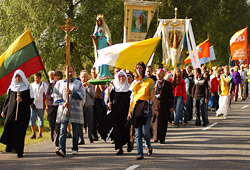Pilgrimages, Indulgences, Piety
The tradition of Šiluva’s indulgenced feast goes back to the 15th century. Within a hundred years, the annual feast had become so popular that even “protestantised” Lithuanians from Prussia would travel 100 km to take part. In the second half of the 16th century, when Šiluva came under the influence of Calvinists, the Catholics lost their church building, and the tradition of the indulgenced feast came to a halt. Its celebration resumed when Catholics recovered the church land. From that time on, people have been drawn to Šiluva not only by the titular feast itself, but also by the ever more widely spread news about the apparition of Mary and about the painting of the Blessed Virgin and the Child which hangs in the church at Šiluva and which since 1622 has been associated with special graces.
Already in the 17th century, pilgrims began travelling to Šiluva in processions, which were usually led by parish priests. Students of Kražiai College would travel together to Šiluva at the end of the school year to thank the Mother of God. Some 40,000 pilgrims turned out during the indulgenced feast of 1866, which marked the centenary of the coronation of Šiluva’s image of Mary and Jesus. After that, the Tsarist regime outlawed processions. The ban lasted until 1905, but did not keep people from visiting Šiluva. Organized parish processions to Šiluva started anew in 1906, when the titular feast attracted 50,000 pilgrims.
During Lithuania’s period of independence between the two World Wars, groups travelled to the indulgenced feast at Šiluva not only from nearby, but also from Kaunas. Up to 100,000 participants gathered at the annual celebrations, which from 1933 were also used as an occasion for religious congresses.
The indulgenced feast tradition was not disrupted even during the years of Soviet occupation. At first, efforts were made to deride the feast of Šilinės in the press. Then, from 1960, the police got involved in an all-out attempt to prevent or scare pilgrims from coming here. Roads leading to the small town were blocked, some drivers’ licenses were taken away, and passengers were forced to get off. The organizers of several pious processions to Šiluva were sentenced to three years in prison. On the last Sunday of August, young people – and in particular a group called the Friends of the Eucharist – would walk in procession from the town of Tytuvėnai to Šiluva. Some 500-600 people took part in that procession in 1975, while in 1976 there were 600-700, and in 1977 almost 1,000 joined in.
When Lithuania regained independence, the titular feast at Šiluva became one of the most important events in the religious life of the country. The eight-day indulgenced feast of the Nativity of the Blessed Virgin Mary begins each year on September 8. Before that, on the last Sunday of August, two processions of pilgrims proceed to the shrine of Šiluva: one from the Dubysa Valley in the direction of Raseiniai, led by the Archbishop of Kaunas, and the other from the town of Tytuvėnai, led by the Bishop of Šiauliai. Another tradition is a three-day pilgrimage in which young people and soldiers walk to the Šilinės celebration from the Hill of Crosses near Šiauliai, led by the bishop ordinary of the Lithuanian military. During the feast, prayers are offered for a variety of intentions, catechetical sessions are held, as are religious plays and concerts. Specific days are devoted to particular themes or groups, such as the military, health care personnel, families or young people.
Lithuanians living outside the country also celebrate Šiluva’s annual feast. The first such feast outside Lithuania took place on September 8, 1947 at the Marian shrine of Altötting in Bavaria. The second was soon after, on November 16, 1947 at the shrine of Our Lady of Absom in the Austrian state of Tyrol. Lithuanian parishes in Argentina, Uruguay, the United States, Canada and other countries have celebrated Šilinės. Communities of Lithuanians all around the world observed the Year of Our Lady of Šiluva that Archbishop S. Tamkevičius declared for the occasion of the 400-year jubilee of Mary’s apparition.








